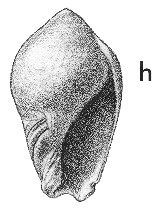
Revised descriptions of New Zealand Cenozoic Mollusca from Beu and Maxwell (1990)

 | Revised descriptions of New Zealand Cenozoic Mollusca from Beu and Maxwell (1990) | 
|
  (Pl. 22h): GS5177, J38/f9526, Tengawai River near Sutherlands, South Canterbury, Altonian (GNS) |
Beu & Maxwell (1990): Chapter 11; p. 204; pl. 22 h.
Synonymy: "Ancillaria pseudaustralis var. Tate" of Suter (not of Tate, 1889); "Ancillaria papillata Tate" of Suter (not of Tate, 1889); Ancilla (Baryspira) robusta Marwick 1924e, p. 322; Baryspira robusta; B. (Gemaspira) robusta
Type species of Gemaspira Olson, 1956, synonymised with Baryspira by Beu (1970a)
Classification: Olividae: Ancillinae
Description: Large for subgenus (height 35-65 mm), elongate-ovate, spire conic, about 0.3 total height, apex pointed or narrowly rounded, apical whorls obscured by heavy spire callus. Periphery of last whorl rounded, sides straight or slightly convex except for weak subangulation at edge of fasciole. Sculpture, apart from growth lines, of weak spiral grooves and rows of small, rather obscure pits around periphery of last whorl. Aperture capacious, some shells with a short, shallow, slightly curved groove (posterior siphonal groove) extending from posterior end. Anterior notch deep, fasciole bounded by low, rounded ridge, covered by smooth callus that extends up to edge of depressed band. Columella moderately long, straight or weakly concave, subvertical, with 4-8 very weak plaits or grooves. Some shells with a prominent, sharp, oblique external ridge extending from near anterior end of columella, typically accompanied by a slightly weaker, parallel one above, neither entering aperture. Parietal callus very prominent, spreading from outer lip up to, or nearly to apex and for 180° or more around upper part of last whorl; thickness highly variable, polished on well preserved shells. Callus extending along columella to anterior notch.
Comparison: Amalda robusta is readily distinguished from most other species of Amalda (Baryspira) by its large size, its pointed or narrowly rounded apex, its prominent, spreading parietal callus, and its almost straight columella. A. (Baryspira) platycephala (Otaian, Waiheke Island) differs from typical specimens of A. robusta in its smaller size (height c. 30 mm), its more rounded apex, and its more strongly concave columella. Olson (1956, p. 16) recorded A. platycephala from the Mount Harris Formation at Tengawai River from a lower horizon (Otaian) than that of typical A. robusta. These specimens are considerably larger than topotypes of A. platycephala (height c. 50 mm) but most have a more rounded apex and a more concave columella than typical A. robusta. Their identity is uncertain, but they seem to represent a variant of A. robusta rather than A. platycephala.
Distribution: Duntroonian-Altonian; Mount Harris Formation, Mt Harris, South Canterbury, Otaian or Altonian (type); Ardgowan Shellbed; Southburn Sand, Tengawai River, near Sutherlands; Mount Harris Formation, Bluecliffs, Otaio River; Otekaike Limestone, Trig Z, Otiake; Chatton Formation, Shell Gully, Chatton. Moderately common in shallow-water sandstone, less common in siltstone.
Cite this publication as: "A.G. Beu and J.I. Raine (2009). Revised
descriptions of New Zealand Cenozoic Mollusca from Beu and Maxwell (1990). GNS
Science miscellaneous series no. 27."
© GNS Science, 2009
ISBN
978-0-478-19705-1
ISSN 1177-2441
(Included with a PDF facsimile file
copy of New Zealand Geological Survey Paleontological Bulletin 58 in CD version
from: Publications Officer, GNS Science, P.O. Box 30368 Lower Hutt, New
Zealand)